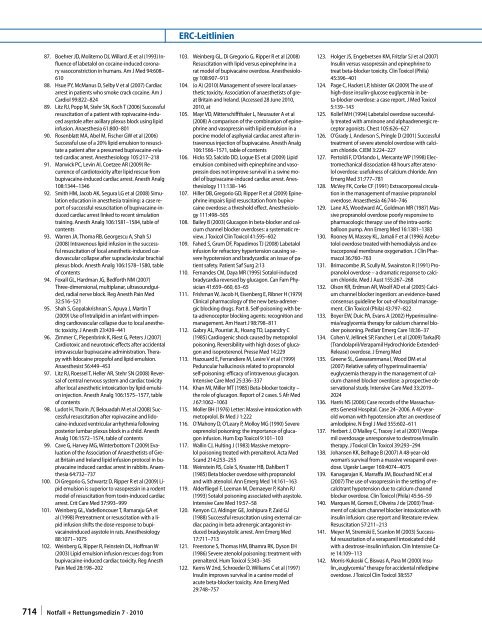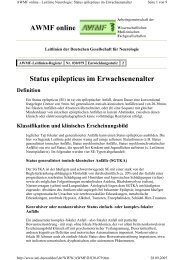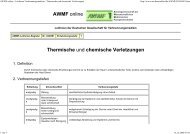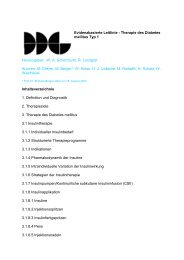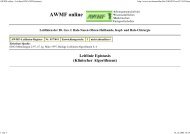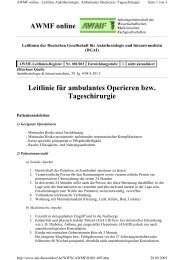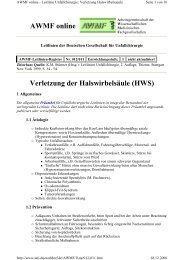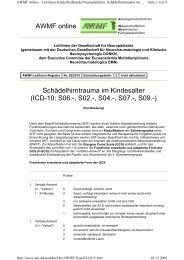Kreislaufstillstand unter besonderen Umständen ... - Reanitrain
Kreislaufstillstand unter besonderen Umständen ... - Reanitrain
Kreislaufstillstand unter besonderen Umständen ... - Reanitrain
Erfolgreiche ePaper selbst erstellen
Machen Sie aus Ihren PDF Publikationen ein blätterbares Flipbook mit unserer einzigartigen Google optimierten e-Paper Software.
ERC-Leitlinien<br />
87. Boehrer JD, Moliterno DJ, Willard JE et al (1993) Influence<br />
of labetalol on cocaine-induced coronary<br />
vasoconstriction in humans. Am J Med 94:608–<br />
610<br />
88. Hsue PY, McManus D, Selby V et al (2007) Cardiac<br />
arrest in patients who smoke crack cocaine. Am J<br />
Cardiol 99:822–824<br />
89. Litz RJ, Popp M, Stehr SN, Koch T (2006) Successful<br />
resuscitation of a patient with ropivacaine-induced<br />
asystole after axillary plexus block using lipid<br />
infusion. Anaesthesia 61:800–801<br />
90. Rosenblatt MA, Abel M, Fischer GW et al (2006)<br />
Successful use of a 20% lipid emulsion to resuscitate<br />
a patient after a presumed bupivacaine-related<br />
cardiac arrest. Anesthesiology 105:217–218<br />
91. Marwick PC, Levin AI, Coetzee AR (2009) Recurrence<br />
of cardiotoxicity after lipid rescue from<br />
bupivacaine-induced cardiac arrest. Anesth Analg<br />
108:1344–1346<br />
92. Smith HM, Jacob AK, Segura LG et al (2008) Simulation<br />
education in anesthesia training: a case report<br />
of successful resuscitation of bupivacaine-induced<br />
cardiac arrest linked to recent simulation<br />
training. Anesth Analg 106:1581–1584, table of<br />
contents<br />
93. Warren JA, Thoma RB, Georgescu A, Shah SJ<br />
(2008) Intravenous lipid infusion in the successful<br />
resuscitation of local anesthetic-induced cardiovascular<br />
collapse after supraclavicular brachial<br />
plexus block. Anesth Analg 106:1578–1580, table<br />
of contents<br />
94. Foxall GL, Hardman JG, Bedforth NM (2007)<br />
Three-dimensional, multiplanar, ultrasoundguided,<br />
radial nerve block. Reg Anesth Pain Med<br />
32:516–521<br />
95. Shah S, Gopalakrishnan S, Apuya J, Martin T<br />
(2009) Use of Intralipid in an infant with impending<br />
cardiovascular collapse due to local anesthetic<br />
toxicity. J Anesth 23:439–441<br />
96. Zimmer C, Piepenbrink K, Riest G, Peters J (2007)<br />
Cardiotoxic and neurotoxic effects after accidental<br />
intravascular bupivacaine administration. Therapy<br />
with lidocaine propofol and lipid emulsion.<br />
Anaesthesist 56:449–453<br />
97. Litz RJ, Roessel T, Heller AR, Stehr SN (2008) Reversal<br />
of central nervous system and cardiac toxicity<br />
after local anesthetic intoxication by lipid emulsion<br />
injection. Anesth Analg 106:1575–1577, table<br />
of contents<br />
98. Ludot H, Tharin JY, Belouadah M et al (2008) Successful<br />
resuscitation after ropivacaine and lidocaine-induced<br />
ventricular arrhythmia following<br />
posterior lumbar plexus block in a child. Anesth<br />
Analg 106:1572–1574, table of contents<br />
99. Cave G, Harvey MG, Winterbottom T (2009) Evaluation<br />
of the Association of Anaesthetists of Great<br />
Britain and Ireland lipid infusion protocol in bupivacaine<br />
induced cardiac arrest in rabbits. Anaesthesia<br />
64:732–737<br />
100. Di Gregorio G, Schwartz D, Ripper R et al (2009) Lipid<br />
emulsion is superior to vasopressin in a rodent<br />
model of resuscitation from toxin-induced cardiac<br />
arrest. Crit Care Med 37:993–999<br />
101. Weinberg GL, VadeBoncouer T, Ramaraju GA et<br />
al (1998) Pretreatment or resuscitation with a lipid<br />
infusion shifts the dose-response to bupivacaineinduced<br />
asystole in rats. Anesthesiology<br />
88:1071–1075<br />
102. Weinberg G, Ripper R, Feinstein DL, Hoffman W<br />
(2003) Lipid emulsion infusion rescues dogs from<br />
bupivacaine-induced cardiac toxicity. Reg Anesth<br />
Pain Med 28:198–202<br />
103. Weinberg GL, Di Gregorio G, Ripper R et al (2008)<br />
Resuscitation with lipid versus epinephrine in a<br />
rat model of bupivacaine overdose. Anesthesiology<br />
108:907–913<br />
104. (o A) (2010) Management of severe local anaesthetic<br />
toxicity. Association of anaesthetists of great<br />
Britain and Ireland. (Accessed 28 June 2010,<br />
2010, at<br />
105. Mayr VD, Mitterschiffthaler L, Neurauter A et al<br />
(2008) A comparison of the combination of epinephrine<br />
and vasopressin with lipid emulsion in a<br />
porcine model of asphyxial cardiac arrest after intravenous<br />
injection of bupivacaine. Anesth Analg<br />
106:1566–1571, table of contents<br />
106. Hicks SD, Salcido DD, Logue ES et al (2009) Lipid<br />
emulsion combined with epinephrine and vasopressin<br />
does not improve survival in a swine model<br />
of bupivacaine-induced cardiac arrest. Anesthesiology<br />
111:138–146<br />
107. Hiller DB, Gregorio GD, Ripper R et al (2009) Epinephrine<br />
impairs lipid resuscitation from bupivacaine<br />
overdose: a threshold effect. Anesthesiology<br />
111:498–505<br />
108. Bailey B (2003) Glucagon in beta-blocker and calcium<br />
channel blocker overdoses: a systematic review.<br />
J Toxicol Clin Toxicol 41:595–602<br />
109. Fahed S, Grum DF, Papadimos TJ (2008) Labetalol<br />
infusion for refractory hypertension causing severe<br />
hypotension and bradycardia: an issue of patient<br />
safety. Patient Saf Surg 2:13<br />
110. Fernandes CM, Daya MR (1995) Sotalol-induced<br />
bradycardia reversed by glucagon. Can Fam Physician<br />
41:659–660, 63–65<br />
111. Frishman W, Jacob H, Eisenberg E, Ribner H (1979)<br />
Clinical pharmacology of the new beta-adrenergic<br />
blocking drugs. Part 8. Self-poisoning with beta-adrenoceptor<br />
blocking agents: recognition and<br />
management. Am Heart J 98:798–811<br />
112. Gabry AL, Pourriat JL, Hoang TD, Lapandry C<br />
(1985) Cardiogenic shock caused by metoprolol<br />
poisoning. Reversibility with high doses of glucagon<br />
and isoproterenol. Presse Med 14:229<br />
113. Hazouard E, Ferrandiere M, Lesire V et al (1999)<br />
Peduncular hallucinosis related to propranolol<br />
self-poisoning: efficacy of intravenous glucagon.<br />
Intensive Care Med 25:336–337<br />
114. Khan MI, Miller MT (1985) Beta-blocker toxicity –<br />
the role of glucagon. Report of 2 cases. S Afr Med<br />
J 67:1062–1063<br />
115. Moller BH (1976) Letter: Massive intoxication with<br />
metoprolol. Br Med J 1:222<br />
116. O’Mahony D, O’Leary P, Molloy MG (1990) Severe<br />
oxprenolol poisoning: the importance of glucagon<br />
infusion. Hum Exp Toxicol 9:101–103<br />
117. Wallin CJ, Hulting J (1983) Massive metoprolol<br />
poisoning treated with prenalterol. Acta Med<br />
Scand 214:253–255<br />
118. Weinstein RS, Cole S, Knaster HB, Dahlbert T<br />
(1985) Beta blocker overdose with propranolol<br />
and with atenolol. Ann Emerg Med 14:161–163<br />
119. Alderfliegel F, Leeman M, Demaeyer P, Kahn RJ<br />
(1993) Sotalol poisoning associated with asystole.<br />
Intensive Care Med 19:57–58<br />
120. Kenyon CJ, Aldinger GE, Joshipura P, Zaid GJ<br />
(1988) Successful resuscitation using external cardiac<br />
pacing in beta adrenergic antagonist-induced<br />
bradyasystolic arrest. Ann Emerg Med<br />
17:711–713<br />
121. Freestone S, Thomas HM, Bhamra RK, Dyson EH<br />
(1986) Severe atenolol poisoning: treatment with<br />
prenalterol. Hum Toxicol 5:343–345<br />
122. Kerns W 2nd, Schroeder D, Williams C et al (1997)<br />
Insulin improves survival in a canine model of<br />
acute beta-blocker toxicity. Ann Emerg Med<br />
29:748–757<br />
123. Holger JS, Engebretsen KM, Fritzlar SJ et al (2007)<br />
Insulin versus vasopressin and epinephrine to<br />
treat beta-blocker toxicity. Clin Toxicol (Phila)<br />
45:396–401<br />
124. Page C, Hacket LP, Isbister GK (2009) The use of<br />
high-dose insulin-glucose euglycemia in beta-blocker<br />
overdose: a case report. J Med Toxicol<br />
5:139–143<br />
125. Kollef MH (1994) Labetalol overdose successfully<br />
treated with amrinone and alphaadrenergic receptor<br />
agonists. Chest 105:626–627<br />
126. O’Grady J, Anderson S, Pringle D (2001) Successful<br />
treatment of severe atenolol overdose with calcium<br />
chloride. CJEM 3:224–227<br />
127. Pertoldi F, D’Orlando L, Mercante WP (1998) Electromechanical<br />
dissociation 48 hours after atenolol<br />
overdose: usefulness of calcium chloride. Ann<br />
Emerg Med 31:777–781<br />
128. McVey FK, Corke CF (1991) Extracorporeal circulation<br />
in the management of massive propranolol<br />
overdose. Anaesthesia 46:744–746<br />
129. Lane AS, Woodward AC, Goldman MR (1987) Massive<br />
propranolol overdose poorly responsive to<br />
pharmacologic therapy: use of the intra-aortic<br />
balloon pump. Ann Emerg Med 16:1381–1383<br />
130. Rooney M, Massey KL, Jamali F et al (1996) Acebutolol<br />
overdose treated with hemodialysis and extracorporeal<br />
membrane oxygenation. J Clin Pharmacol<br />
36:760–763<br />
131. Brimacombe JR, Scully M, Swainston R (1991) Propranolol<br />
overdose – a dramatic response to calcium<br />
chloride. Med J Aust 155:267–268<br />
132. Olson KR, Erdman AR, Woolf AD et al (2005) Calcium<br />
channel blocker ingestion: an evidence-based<br />
consensus guideline for out-of-hospital management.<br />
Clin Toxicol (Phila) 43:797–822<br />
133. Boyer EW, Duic PA, Evans A (2002) Hyperinsulinemia/euglycemia<br />
therapy for calcium channel blocker<br />
poisoning. Pediatr Emerg Care 18:36–37<br />
134. Cohen V, Jellinek SP, Fancher L et al (2009) Tarka(R)<br />
(Trandolapril/Verapamil Hydrochloride Extended-<br />
Release) overdose. J Emerg Med<br />
135. Greene SL, Gawarammana I, Wood DM et al<br />
(2007) Relative safety of hyperinsulinaemia/<br />
euglycaemia therapy in the management of calcium<br />
channel blocker overdose: a prospective observational<br />
study. Intensive Care Med 33:2019–<br />
2024<br />
136. Harris NS (2006) Case records of the Massachusetts<br />
General Hospital. Case 24–2006. A 40-yearold<br />
woman with hypotension after an overdose of<br />
amlodipine. N Engl J Med 355:602–611<br />
137. Herbert J, O’Malley C, Tracey J et al (2001) Verapamil<br />
overdosage unresponsive to dextrose/insulin<br />
therapy. J Toxicol Clin Toxicol 39:293–294<br />
138. Johansen KK, Belhage B (2007) A 48-year-old<br />
woman’s survival from a massive verapamil overdose.<br />
Ugeskr Laeger 169:4074–4075<br />
139. Kanagarajan K, Marraffa JM, Bouchard NC et al<br />
(2007) The use of vasopressin in the setting of recalcitrant<br />
hypotension due to calcium channel<br />
blocker overdose. Clin Toxicol (Phila) 45:56–59<br />
140. Marques M, Gomes E, Oliveira J de (2003) Treatment<br />
of calcium channel blocker intoxication with<br />
insulin infusion: case report and literature review.<br />
Resuscitation 57:211–213<br />
141. Meyer M, Stremski E, Scanlon M (2003) Successful<br />
resuscitation of a verapamil intoxicated child<br />
with a dextrose-insulin infusion. Clin Intensive Care<br />
14:109–113<br />
142. Morris-Kukoski C, Biswas A, Para M (2000) Insulin<br />
„euglycemia“ therapy for accidental nifedipine<br />
overdose. J Toxicol Clin Toxicol 38:557<br />
714 | Notfall + Rettungsmedizin 7 · 2010


